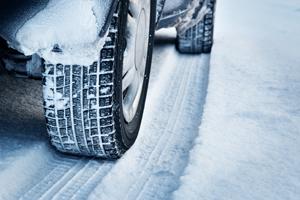Tips before you drive on icy roads

Having your vehicle break down in the freezing cold can be a dangerous ordeal.
Before the icy weather sets in, take the time to prepare your ride for the winter, so you can travel safely – and warmly – to your destinations.
Here are some tips to help you get ready:
Schedule a winter maintenance check
Change your oil prior to winter, and have a mechanic check these foundational parts to ensure they are in good working order:
- Battery
- Heating and cooling system
- Brakes
- Belts
- Spark plugs
- Wires and cables
- Hoses
Stock your vehicle with a cold weather emergency kit
Be sure to include essential items such as:
- Snow shovel
- Ice scraper
- Sand or kitty litter (to get traction under tires)
- Jumper cables
- Flashlight
- Warm blankets
- Flares
- Antifreeze
- Extra food and water
Consider switching to snow or new all-season tires
While it may seem like a hassle to change your tires seasonally, opting for snow tires can improve your vehicle’s traction on icy or snowy roads. If you live in areas that see extreme cold during the winter, where roads are regularly coated with snow, consider adding chains to your tires.
Also, make sure to monitor your tire pressure routinely and keep it at the manufacturer’s recommended setting, as colder weather will cause tires to deflate faster.
Use winterized blades
Upgrading to winterized windshield wipers will help prevent the buildup of snow and ice on the wiper blades. Also, consider winterized wiper fluid to prevent that liquid from freezing.
Swap out your floor mats
Consider using thicker material (such as rubber) to better withstand slushy conditions. Refer to your manufacturer’s specs to make sure you have the correct size and fit for your vehicle. A worn or slick floor mat can interfere with how you use the accelerator and brake pedal – increasing your risk of a crash.
Winter storm driving tips
Even with careful planning, sometimes you might find yourself behind the wheel in less-than-ideal wintry conditions. In situations like these:
Avoid the height of the storm
Stay tuned into the weather forecast to avoid deteriorating conditions and consider public transportation, if possible.
Warm your car ahead of time. This not only helps keep you warm in cold weather, but also allows your vehicle's battery to generate more power. Avoid warming your car up if parked in an enclosed area like a garage.
Clear your exhaust pipe
A blocked pipe could cause carbon monoxide poisoning for those traveling in the car while the engine is running.
Fill up your gas tank early. This will make sure you can get to where you are going and prevent your gas line from freezing.
Give snowplows extra space on the road
Plows make wide turns and sometimes slow down to move piling snow. Stay a few car lengths behind them while they clear a path.
Fully charge your cellphone
Also, consider packing a car charger so you can communicate in the event of a winter auto emergency.
Drive slowly
This will mean allowing for extra time to drive, but can help prevent spinouts and other driving challenges on slippery roads.
Sources
Related resources
Tips before you drive on icy roads
Having your vehicle break down in the freezing cold can be a dangerous ordeal.
Before the icy weather sets in, take the time to prepare your ride for the winter, so you can travel safely – and warmly – to your destinations.
Here are some tips to help you get ready:
Schedule a winter maintenance check
Change your oil prior to winter, and have a mechanic check these foundational parts to ensure they are in good working order:
- Battery
- Heating and cooling system
- Brakes
- Belts
- Spark plugs
- Wires and cables
- Hoses
Stock your vehicle with a cold weather emergency kit
Be sure to include essential items such as:
- Snow shovel
- Ice scraper
- Sand or kitty litter (to get traction under tires)
- Jumper cables
- Flashlight
- Warm blankets
- Flares
- Antifreeze
- Extra food and water
Consider switching to snow or new all-season tires
While it may seem like a hassle to change your tires seasonally, opting for snow tires can improve your vehicle’s traction on icy or snowy roads. If you live in areas that see extreme cold during the winter, where roads are regularly coated with snow, consider adding chains to your tires.
Also, make sure to monitor your tire pressure routinely and keep it at the manufacturer’s recommended setting, as colder weather will cause tires to deflate faster.
Use winterized blades
Upgrading to winterized windshield wipers will help prevent the buildup of snow and ice on the wiper blades. Also, consider winterized wiper fluid to prevent that liquid from freezing.
Swap out your floor mats
Consider using thicker material (such as rubber) to better withstand slushy conditions. Refer to your manufacturer’s specs to make sure you have the correct size and fit for your vehicle. A worn or slick floor mat can interfere with how you use the accelerator and brake pedal – increasing your risk of a crash.
Winter storm driving tips
Even with careful planning, sometimes you might find yourself behind the wheel in less-than-ideal wintry conditions. In situations like these:
Avoid the height of the storm
Stay tuned into the weather forecast to avoid deteriorating conditions and consider public transportation, if possible.
Warm your car ahead of time. This not only helps keep you warm in cold weather, but also allows your vehicle's battery to generate more power. Avoid warming your car up if parked in an enclosed area like a garage.
Clear your exhaust pipe
A blocked pipe could cause carbon monoxide poisoning for those traveling in the car while the engine is running.
Fill up your gas tank early. This will make sure you can get to where you are going and prevent your gas line from freezing.
Give snowplows extra space on the road
Plows make wide turns and sometimes slow down to move piling snow. Stay a few car lengths behind them while they clear a path.
Fully charge your cellphone
Also, consider packing a car charger so you can communicate in the event of a winter auto emergency.
Drive slowly
This will mean allowing for extra time to drive, but can help prevent spinouts and other driving challenges on slippery roads.
Sources
Related resources
Tips before you drive on icy roads
Having your vehicle break down in the freezing cold can be a dangerous ordeal.
Before the icy weather sets in, take the time to prepare your ride for the winter, so you can travel safely – and warmly – to your destinations.
Here are some tips to help you get ready:
Schedule a winter maintenance check
Change your oil prior to winter, and have a mechanic check these foundational parts to ensure they are in good working order:
- Battery
- Heating and cooling system
- Brakes
- Belts
- Spark plugs
- Wires and cables
- Hoses
Stock your vehicle with a cold weather emergency kit
Be sure to include essential items such as:
- Snow shovel
- Ice scraper
- Sand or kitty litter (to get traction under tires)
- Jumper cables
- Flashlight
- Warm blankets
- Flares
- Antifreeze
- Extra food and water
Consider switching to snow or new all-season tires
While it may seem like a hassle to change your tires seasonally, opting for snow tires can improve your vehicle’s traction on icy or snowy roads. If you live in areas that see extreme cold during the winter, where roads are regularly coated with snow, consider adding chains to your tires.
Also, make sure to monitor your tire pressure routinely and keep it at the manufacturer’s recommended setting, as colder weather will cause tires to deflate faster.
Use winterized blades
Upgrading to winterized windshield wipers will help prevent the buildup of snow and ice on the wiper blades. Also, consider winterized wiper fluid to prevent that liquid from freezing.
Swap out your floor mats
Consider using thicker material (such as rubber) to better withstand slushy conditions. Refer to your manufacturer’s specs to make sure you have the correct size and fit for your vehicle. A worn or slick floor mat can interfere with how you use the accelerator and brake pedal – increasing your risk of a crash.
Winter storm driving tips
Even with careful planning, sometimes you might find yourself behind the wheel in less-than-ideal wintry conditions. In situations like these:
Avoid the height of the storm
Stay tuned into the weather forecast to avoid deteriorating conditions and consider public transportation, if possible.
Warm your car ahead of time. This not only helps keep you warm in cold weather, but also allows your vehicle's battery to generate more power. Avoid warming your car up if parked in an enclosed area like a garage.
Clear your exhaust pipe
A blocked pipe could cause carbon monoxide poisoning for those traveling in the car while the engine is running.
Fill up your gas tank early. This will make sure you can get to where you are going and prevent your gas line from freezing.
Give snowplows extra space on the road
Plows make wide turns and sometimes slow down to move piling snow. Stay a few car lengths behind them while they clear a path.
Fully charge your cellphone
Also, consider packing a car charger so you can communicate in the event of a winter auto emergency.
Drive slowly
This will mean allowing for extra time to drive, but can help prevent spinouts and other driving challenges on slippery roads.
Sources
Related resources
Tips before you drive on icy roads
Having your vehicle break down in the freezing cold can be a dangerous ordeal.
Before the icy weather sets in, take the time to prepare your ride for the winter, so you can travel safely – and warmly – to your destinations.
Here are some tips to help you get ready:
Schedule a winter maintenance check
Change your oil prior to winter, and have a mechanic check these foundational parts to ensure they are in good working order:
- Battery
- Heating and cooling system
- Brakes
- Belts
- Spark plugs
- Wires and cables
- Hoses
Stock your vehicle with a cold weather emergency kit
Be sure to include essential items such as:
- Snow shovel
- Ice scraper
- Sand or kitty litter (to get traction under tires)
- Jumper cables
- Flashlight
- Warm blankets
- Flares
- Antifreeze
- Extra food and water
Consider switching to snow or new all-season tires
While it may seem like a hassle to change your tires seasonally, opting for snow tires can improve your vehicle’s traction on icy or snowy roads. If you live in areas that see extreme cold during the winter, where roads are regularly coated with snow, consider adding chains to your tires.
Also, make sure to monitor your tire pressure routinely and keep it at the manufacturer’s recommended setting, as colder weather will cause tires to deflate faster.
Use winterized blades
Upgrading to winterized windshield wipers will help prevent the buildup of snow and ice on the wiper blades. Also, consider winterized wiper fluid to prevent that liquid from freezing.
Swap out your floor mats
Consider using thicker material (such as rubber) to better withstand slushy conditions. Refer to your manufacturer’s specs to make sure you have the correct size and fit for your vehicle. A worn or slick floor mat can interfere with how you use the accelerator and brake pedal – increasing your risk of a crash.
Winter storm driving tips
Even with careful planning, sometimes you might find yourself behind the wheel in less-than-ideal wintry conditions. In situations like these:
Avoid the height of the storm
Stay tuned into the weather forecast to avoid deteriorating conditions and consider public transportation, if possible.
Warm your car ahead of time. This not only helps keep you warm in cold weather, but also allows your vehicle's battery to generate more power. Avoid warming your car up if parked in an enclosed area like a garage.
Clear your exhaust pipe
A blocked pipe could cause carbon monoxide poisoning for those traveling in the car while the engine is running.
Fill up your gas tank early. This will make sure you can get to where you are going and prevent your gas line from freezing.
Give snowplows extra space on the road
Plows make wide turns and sometimes slow down to move piling snow. Stay a few car lengths behind them while they clear a path.
Fully charge your cellphone
Also, consider packing a car charger so you can communicate in the event of a winter auto emergency.
Drive slowly
This will mean allowing for extra time to drive, but can help prevent spinouts and other driving challenges on slippery roads.





